Back in the day, having a blog was a whole different ballgame. Creating a killer blog that could outshine your competitors was a piece of cake compared to the cutthroat landscape of today, with millions of blogs vying for traffic and gunning for that top spot in organic search results.
But don’t let that scare you off! Despite the fierce competition, there’s still plenty of room to make your mark in the blogosphere. In fact, top-notch written content remains absolutely crucial for driving traffic, generating leads, and boosting sales. A well-crafted blog still makes perfect sense for those looking to rake in passive income for years to come. A blog with killer content, impressive traffic, high-quality backlinks, and a solid monetization strategy can truly make all the difference.
However, there are many crucial requirements that newbie bloggers often overlook. Simply dishing out good content and posting regularly won’t cut it anymore.
In this article, we’ll dive into 7 must-haves that you absolutely need to meet in order to ensure the success of your blog. So let’s dig in and explore what it takes to create a thriving blog, and what rookie mistakes to steer clear of.
Table of Contents
Use the right keywords
Keywords are still the be-all and end-all for websites and therefore also for blogs. People always have a search or purchase impulse which is also reflected in the keywords. Those who are looking for blog themes are not looking for “website designs” and those who are looking for cars are not looking for “vehicles”, but for a certain brand or model.

You have to apply this to your blog in order to automatically optimize each article for a specific keyword. Only what is found by Google itself can later be searched for and found by users. Keywords are still THE factor for telling Google what your website is about.

So be sure to always include matching terms in your article and stick to a particular keyword, instead of targeting multiple keywords at once. Most of the time, the latter is difficult to achieve and you should first concentrate on the main keyword, including its extensions. Not in the sense of spamming, but simply by naturally incorporating it into your text and also weaving terms around the keyword into the article. This usually brings the best results.
Read: 6 Must-haves For Successful B2B Website in 2022
Why keywords are important ?
- You can use them to find topics for your editorial plan, to structure the content of blog articles and generally for market research.
- Analyzing and researching keywords to better understand your customers’ desires, fears and problems (use keyword finder tools like SEMRush or ahrefs keyword explorer – see sections below).
- You will find out which language your customers speak.
- You can use keyword analysis to better assess whether a blog article or an offer will be well received or not. Because if a problem is often googled, it is more likely that you will get visitors for to blog article or find customers for your products.
How to put keywords on your site?
Learning how to put keywords on the site is not just randomly distributing these terms on your platform.
Below you will learn how to perform the 3 steps to perform this strategically:
- Select correct keywords
- SEO tools for finding keywords (keywords for seo)
- Where to place the keywords on the site
Read: 9 Ways You Can Make Money From Blogs
Select correct keywords
The first step in placing keywords on the site is to find out what are the strategic terms for your business.
- What keywords people are using?
- Which terms correspond to your niche?
Understanding which keywords should be on your website or blog is the first step for your organic ranking strategy to work .
One way to find keywords easily is to simply start typing a phrase related to your business, on Google, and it will start displaying several options, as in the example below:

Google also displays keywords related to search terms at the bottom of the search result page. These are the terms that the search engine considers most relevant to the query and suggests them in an attempt to help the user find specific content and according to their real search intentions.
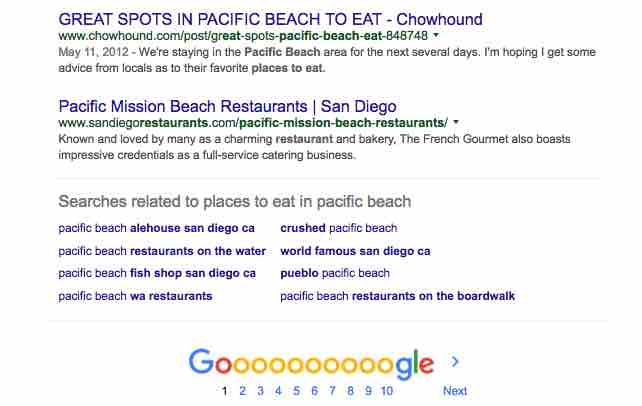
SEO tools for finding keywords
SEMRush
SEMrush for instance is an SEO tool that has many useful features for search engine optimization. One of them is its position monitoring framework.

Using SEMrush, you can:
- See the individual performance of each pre-registered keyword
- See the rate of improvement in overall positioning
- See the distribution of keywords by ranking
- Filter by date to see history
- Add new keywords whenever you want
The tool is paid (check out SEMRush pricing here), but it is an excellent investment if you want to increase your SEO analysis.
Read: How to start a blog for beginners
Pro Rank Tracker
Pro Rank Tracker is a fully focused SEO tool in tracking keyword positions. The tool promises to deliver everything related to the monitoring of keywords.

One of its main features is the very accurate reports it generates. Like SEMrush, it also has many graphs useful for more refined analysis.
Although, currently, almost all the focus of SEO analysts for most new bloggers is on Google, Pro Rank Tracker offers a monitoring of the rankings of Bing and also Yahoo.
The tool is paid.
WebXtool

WebXtool , has a broader arsenal of SEO tools, covering many other steps in addition to monitoring positions. However, it is its functionality for tracking rankings that stands out.
It has a free version with a small limit on the number of keywords to track, but in its paid version the sky’s the limit.
Its functionality is very complete, including graph analysis, positioning history and many other qualities of the tools already mentioned here.
Read: Link Building: 11 Must-Have Tools for 2022
Try the free version to get to know the tool better and draw your conclusions.
There are also other tools:
- Several keyword tools such as KWFinder, ahrefs(see SEO tools section)
- Google Search Console (see SEO tools section)
- Keywords everywhere (great very cheap! chrome extension that we recommend)
- Google keyword planner
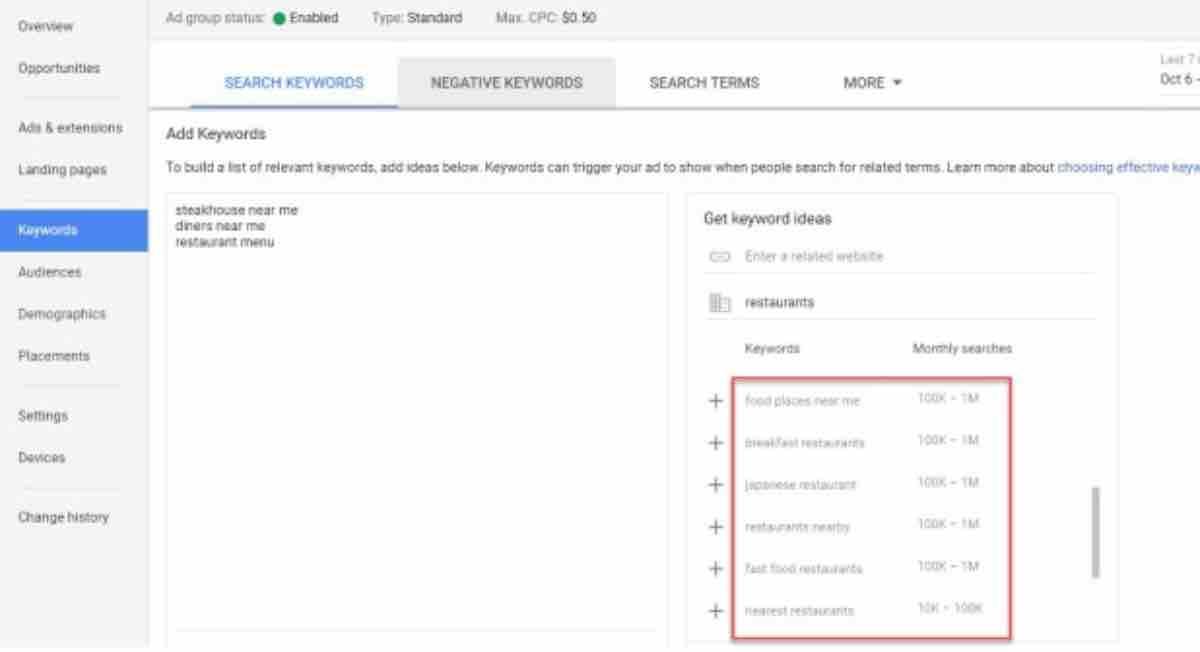
Read: Best Web Hosting – 2022 Buyer’s Guide
Where to put keywords on the website
In addition to knowing which keywords to insert on your site, it is important to understand where to use them.
Ideally, keywords should appear in the following places in your article:
- In the heading (h1)
- In at least one subheading (h2 or h3)
- In the first paragraph of the blog post
- Several times in the main text
- In the alt tag and in the file name of an image
- In the URL / permalink
- In the meta title and in the meta description (the title and description that appears in the search results)
The insertion of these attributes in a content can be done easily with the use of plugins like Yoast , which is free for users of the WordPress platform.
Read: 6 Essential Website Optimization Strategies
Search volume
The search volume (also abbreviated SV) is one of the main criteria when looking for a good keyword.
It indicates how often a search query (usually per month) is entered on Google.
The higher the search volume, the more visitors can land on your website if placed accordingly. For keyword analysis, it is therefore very important that you use at least one tool that shows the search volume (see Google trends below).
Use long-tail keywords
When learning how to put keywords on the site, prioritize the use of long tail keywords, such as “how to cook chicken the japanese way”.
In addition to having less competition, these keywords generate qualified traffic for the content and page, as it answers exactly the question the user is looking for.
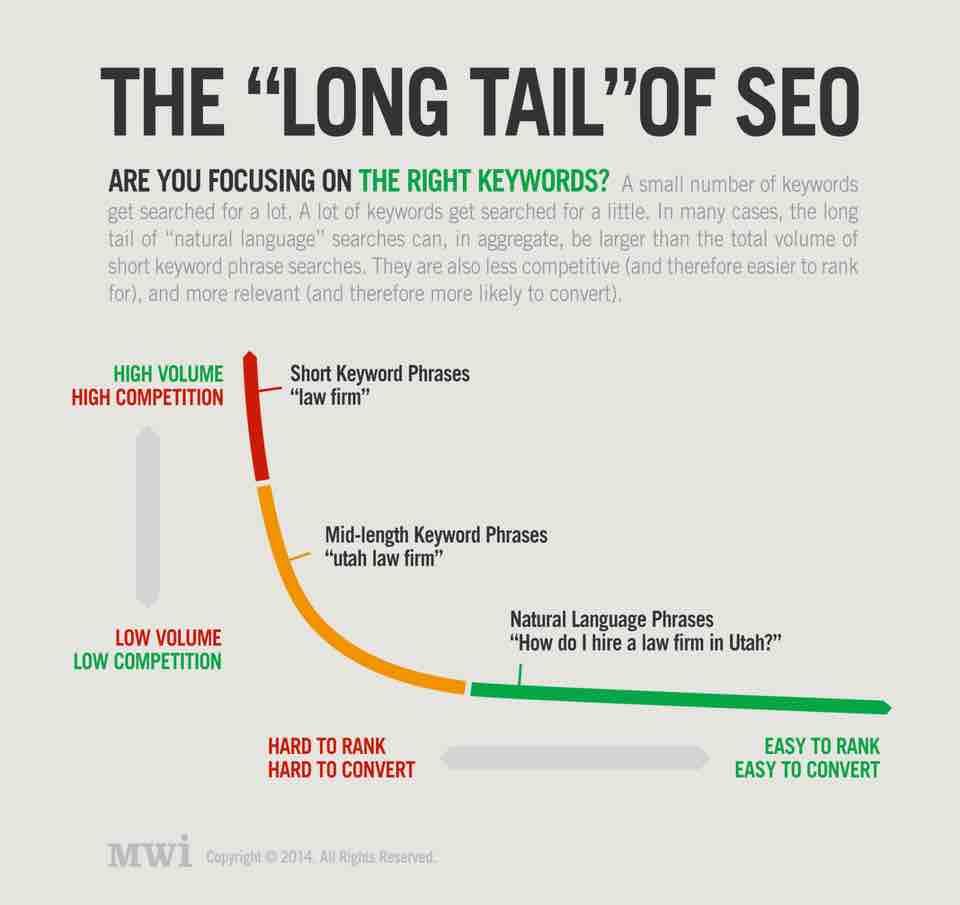
Credits: forbes
If you have an online store, consider the purchase intention when creating your pages . From there, optimize them for long keywords, like “best Linux web hosting services for 2020”.
Trend
In addition to the average search volume of the main keyword (as well as that of the long-tail keywords and synonyms), it may make sense to look at the search volume trend, so that you can see how interest in a search term has developed over time and better estimate how high it could be in the future.
The Google Trends is a useful tool in researching keywords. It does not have a focus on new keyword ideas, but on extracting new information from the keywords that are already in your plan.
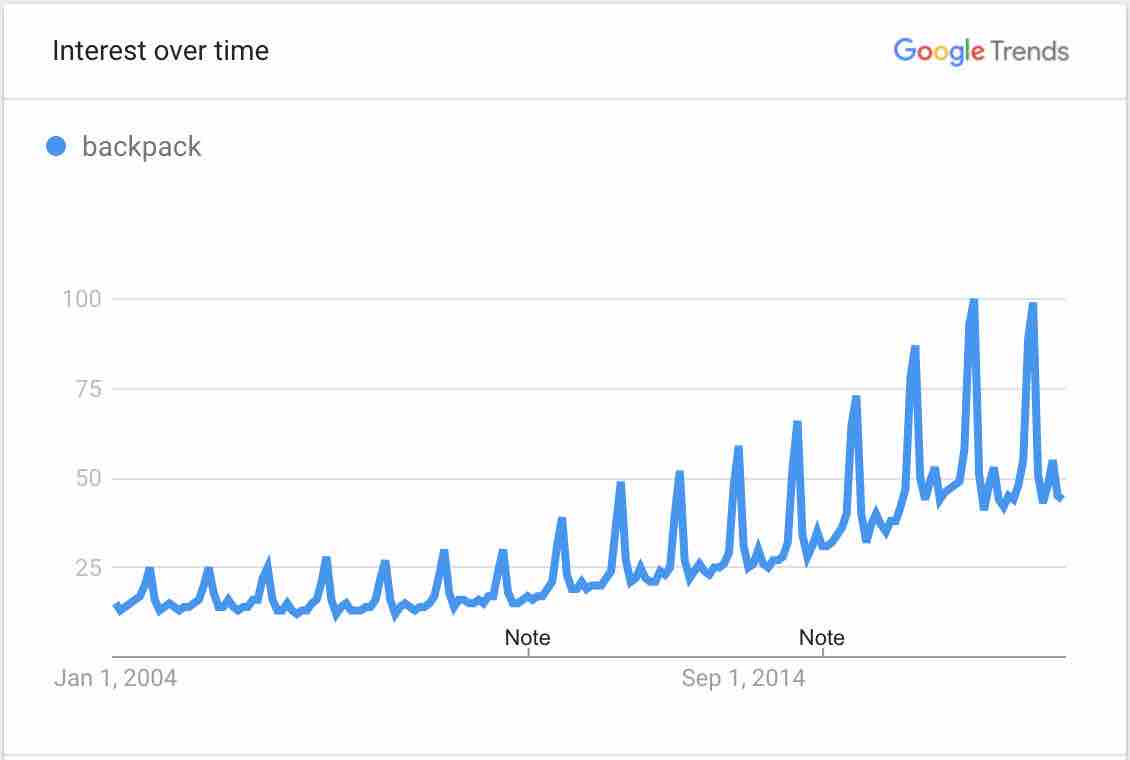
Google Trends excels in:
- Evidence search seasonality for a given keyword
- Compare the search volume of up to 5 keywords at once, within a predetermined period
- View the search distribution of a keyword by region (country, state, city)
Seasonality
Identifying whether a search term has seasonal fluctuations is important to determine when to post or update an item.
This is obvious with some search terms, such as :
- Easter
- summer
- Christmas
- April Fool’s Day
But there are also some keywords whose seasonality can only be determined by a more detailed analysis of the search volume and / or by a deeper introduction to the topic.
SEO Optimization
When you search on Google, you must be asking yourself which strategy was used by the first two websites (notwithstanding ads) to achieve this result and how you can also achieve that with your website. Surely, SEO (Search Engine Optimization) strategies were applied and relevant content was produced to make this happen.

When is SEO useful?
Sometimes, Search engine optimization is is not always worthwhile. For some articles or pages, it simply makes no sense to optimize them for a certain keyword, because specific basic requirements for good rankings are not given. This applies especially to:
- Personal (diary entries, about-me page, internals etc.)
- Posts with little text (pure picture or video posts, link collections)
- Pages with little “unique content” (imprint, data protection declaration, categories and other taxonomies)
- Summaries (weekly reviews, best-of-posts etc.)
SEO is good however for the following (especially the first four):
- Test and experience reports
- Guides articles
- Instructions (recipes, tutorials etc.)
- Knowledge and encyclopedia articles
- News
- Comments, columns or essays
- Interviews and blog presentations
Black hat SEO vs. White hat SEO
In the SEO scene, a distinction is usually made between two directions in optimization: Black hat and white hat SEO.
With White Hat SEO, you should stick to Google’s guidelines for webmasters and try to earn your position on Google search results.
With black hat SEO, you don’t take the rules very carefully.

Black hat SEO is based on the fact that Google’s algorithm (even after more than 20 years of development) can still be manipulated and positive ranking factors can be falsified.
This includes e.g. :
- Buying backlinks
- The establishment of link networks or exchange programs
- Misuse of structured data
- Cloaking ( show website visitors and search engines different content)
As you can imagine, Google doesn’t like to see such strategies.
What are the ranking factors?
Google’s algorithm has over 200 different factors that it uses to determine the ranking of a website for a specific search term.
Some are important, some are unimportant. Some are also specific to individual keywords or industries.
Treating all possible factors in this guide is beyond the scope. That is why we concentrate on the essentials:
- Content (How well does the website answer the search query?)
- User experience
- Backlinks
A good ranking in all three areas is necessary for a top ranking .
Below are some valuable tips that can help your website achieve better rankings :
Title
The most important part of your post is the title. Research indicates that if your title is good, only about ¼ of your audience will read the entire post. So try to create a creative title following some tips like: avoid words that have more than one meaning, use about six words and develop it in a way that relates to the content.

There is nothing more annoying than reading a title that is not related to the subject. In addition, to help with SEO, it is important that the title has up to 65 characters, has strong keywords and when possible, has odd numbers. There are some tools that generate good headlines out here like for instance Sumo headline generator.
The greater the accuracy, the easier it will be to convince visitors and potential leads to keep reading your blog.
Content
How to write a blog and create content that informs and helps people with their problems is the key to success. When a post offers useful information to visitors, your blog receives more links and its ranking in Google naturally improves. If for instance, you write a step by step guide of how to use a new tool that appeared on the market , the chance of your post being read and shared increases.
Generate robust content
Even for product pages, Google likes robust content. This means that the ideal is that you produce content from 1,000 to 1,500 words per page.
In addition to size, quality is also important when it comes to information robustness.
So include in your strategy:
- Internal and external links that add information to the user
- Videos, images and infographics
- Rich content like ebooks and webinars (take the opportunity to capture leads).
Length
Long blog articles often rank better. For optimal rankings, a minimum of 1000 words for your blog articles is recommended.
Readability
The readability of your blog post, i.e. how accessible and understandable your content is to your readers, is an important indicator of the quality of your blog post. Make sure to check the following:
- Spelling and Grammar
- Clarity (use of images, videos, slides, lists, tables, etc.)
- Block length (do not write block sentences that are too long)
- Paragraphs (divide blog posts into meaningful and not too long paragraphs)
- Headings (headings increase the readability of a text enormously)
Humanization
In addition to creating relevant content, it is necessary to “humanize them”. Your blog posts must provide information about tools or news that are part of people’s lives and attract their attention. Focusing on emotion, design and action can help make your content more interesting.
The emotion can be aroused when you touch the visitors of the blog in some way, such as telling stories. The design is also essential, an impacting image or infographic can be used. The action is another important element that can be performed through links or images that involve the reader.
Read: 5 Effective Tips on How to Monetize Your Website in 2022
Alt tag
Use images in your post in harmony with the text and don’t forget to relate them to the main keyword. The most practical way to do this is to rename the image file so that the keyword is present.
SEO WordPress plugins for blogs
Considered one of the best SEO plugin for WordPress, Yoast SEO is currently the most popular WordPress SEO plugin worldwide. It not only optimizes technical aspects of your website, but also supports you in optimizing your website content. With the free SEO plugin you also get a powerful tool to improve the reach of your website.

It offers a checklist that allows you to verify if your post is optimized according to the important aspects of SEO. Another good plugin is the All in One SEO Pack .
Both plugins are widely used by those who have a blog on WordPress and want to keep the blog and its posts always SEO optimized.
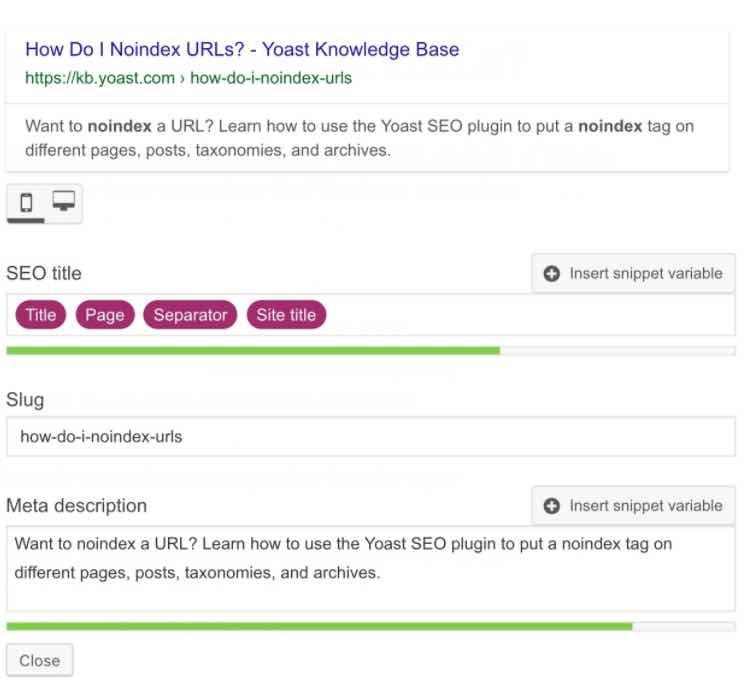
Yoast plugin in WordPress
By grouping the functionalities of the two, it is possible to:
- Make 301 redirects;
- Configure Meta Description templates;
- Configure Meta Title templates;
- Check if the text is optimized for the focus keyword;
- Receive useful SEO tips;
- Block indexing of specific WordPress sessions;
- Make breadcrumbs and internal link optimizations;
- Access the .htaccess file for editing;
- Work with canonical tags;
- Among other features.
Schedule
Keeping your blog up to date is one of the main factors that will lead to achieve better rankings on Google. To do this, create a schedule of posts and follow the progress of your blog traffic through Google Analytics. Ideally, posts should be published daily. If you can’t keep up with this post production pace, you can work by inviting partners to collaborate with your blog or hire a content professional to develop this work.
On page SEO tools
A website’s on-page corrections and optimizations are like putting on your boots to get on the pitch. Everything needs to be in order for all your SEO efforts to be 100% profitable for your website.

This is undoubtedly one of the stages where there is the greatest need for tools. This is because the type of analysis that needs to be done is very thorough and it is not very difficult to miss out some important details when checking all the pages manually.
You will find below some tools that do the job well at this stage:
Screamingfrog
The Screamingfrog is a most complete tool when it comes to on-page optimization. It misses absolutely nothing.

It allows to:
- View URLs for Optimization
- Find tracking errors (for example, 404)
- Optimize images
- Find and evaluate content
- Analyze external and internal links
- Simulate the Google Snippet
- Find duplicate content
- Detect pages that are not indexed
- Test a website speed
- Create and optimize a Sitemap.xml
The tool has a free version, but with some limitations. In the paid version, all of the above can be used without moderation.
If you want to do a great on-page analysis and don’t know where to start, this tool is a must.
Google Search Console
The Google Search Console (former Webmaster Tools) is a very important tool for any website.

Over time, Google Search Console has practically become a protocol for any SEO strategy that is initiated, being indispensable. Undoubtedly one of the major reasons for this is the fact that it is free and also work well with Google Analytics.
Google Search Console also acts as a search engine broker for the SEO expert, warning you whenever there is a penalty or other important notifications.
If you are starting your website from scratch and want it to be optimized for search engines, Google Search Console would need to be configured and linked with Google Analytics .
Google PageSpeed
For those who still don’t know, a website loading speed is a ranking factor . Refer to section ‘Website loading speed’ below for more.

Google PageSpeed has been increasingly sought after in recent years: it provides specific instructions to website owners so that their website loads faster.
The tool is very easy to use and is very useful in optimizing website speed. In addition to helping your site to load faster for desktop users, it also provides instructions specifically for mobile.
GTMetrix
GTmetrix is a popular online tool that scans your site and offers you a very complete report of two sets of metrics ( PageSpeed by Google and YSlow by Yahoo), which in turn award a grade based on the quality of performance of your site .
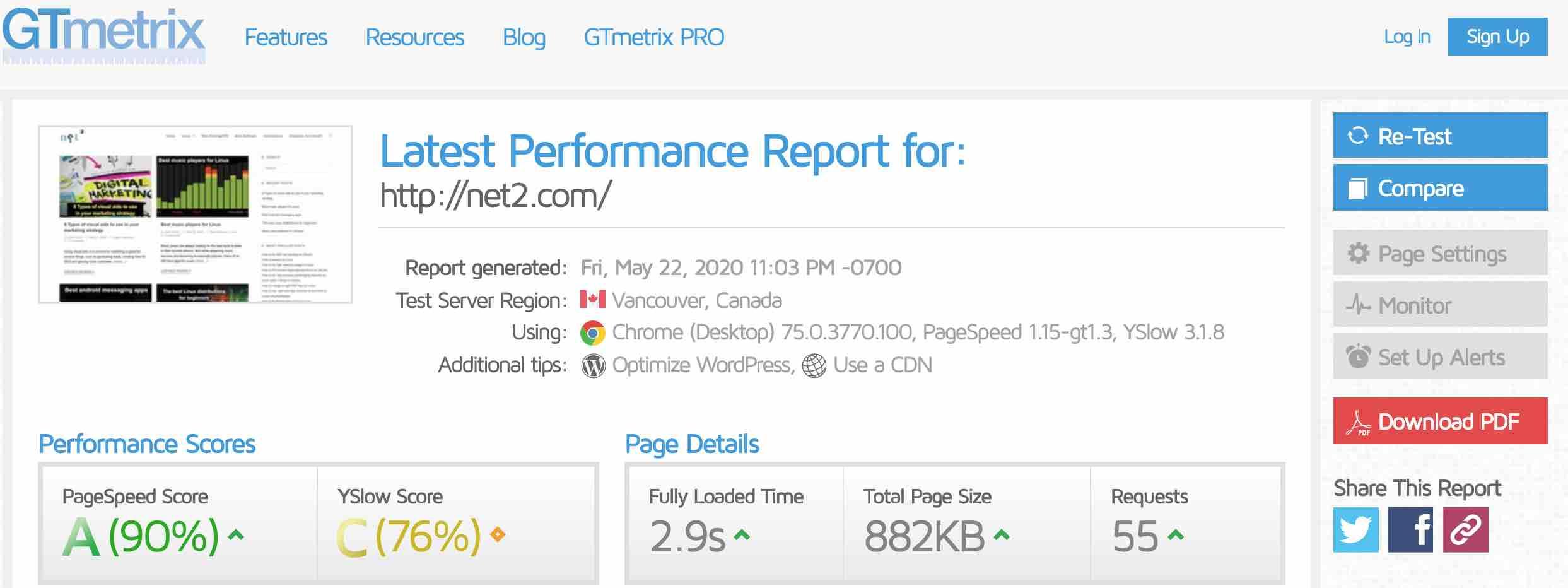
That set of metrics or rules can help you to optimize the speed of your website. Additionally, GTmetrix offers other useful metrics that will help you find bottlenecks that once solved, will help you improve your website loading speed.
Off page SEO tools
In SEO, when we talk about off-page, basically the subject is one: Link Building. Even today, backlinks function as one of the most important ranking factors. It is the way that search engines measure the authority of a website. Refer to the section on ‘Strong Links or Backlinks’ further down in this article for more.

Think of an example with products: the more people recommend a product, the more likely it is to be of high quality, even more so if the people who recommend it have credibility. And it is exactly with this logic that the search engines try to work: if a site has a lot of backlinks from quality websites, it gains an authority with respect to search engines.
Therefore, it is extremely important that this step is very much taken into account when planning the SEO of your website. Like all other steps, there are powerful tools that can help a lot in your Link Building strategy.
Majestic SEO
The Majestic SEO is a tool focused on off-page analysis. The way it works is simple: by entering only one URL, it is possible to make reports related to a website’s backlinks and keywords. In addition to knowing the number of backlinks and what these backlinks are, you can also learn more about their quality through two metrics created by the tool itself: Citation Flow and Trust Flow.

The tool is very complete and has many features related mainly to link building. For example, you can compare one URL with another to see how they compete for links.
More features:
- Show the anchor text of each link
- See all referenced domains
- See link profile diversity
- View link history…
It is possible to use it without paying, but with limited features.
Ahrefs
It is one of the most used SEO tools. With Ahrefs you will be able to know the backlinks that point to a website and the origin of these links, as well as information about:
- Positioning strategy evolution.
- Global Rank or the positioning of a website worldwide.
- Indicates the backlinks and domains from which these links originate.
- Indicates the IP origin of the backlinks, as well as the domain to which the IP belongs to avoid spam.
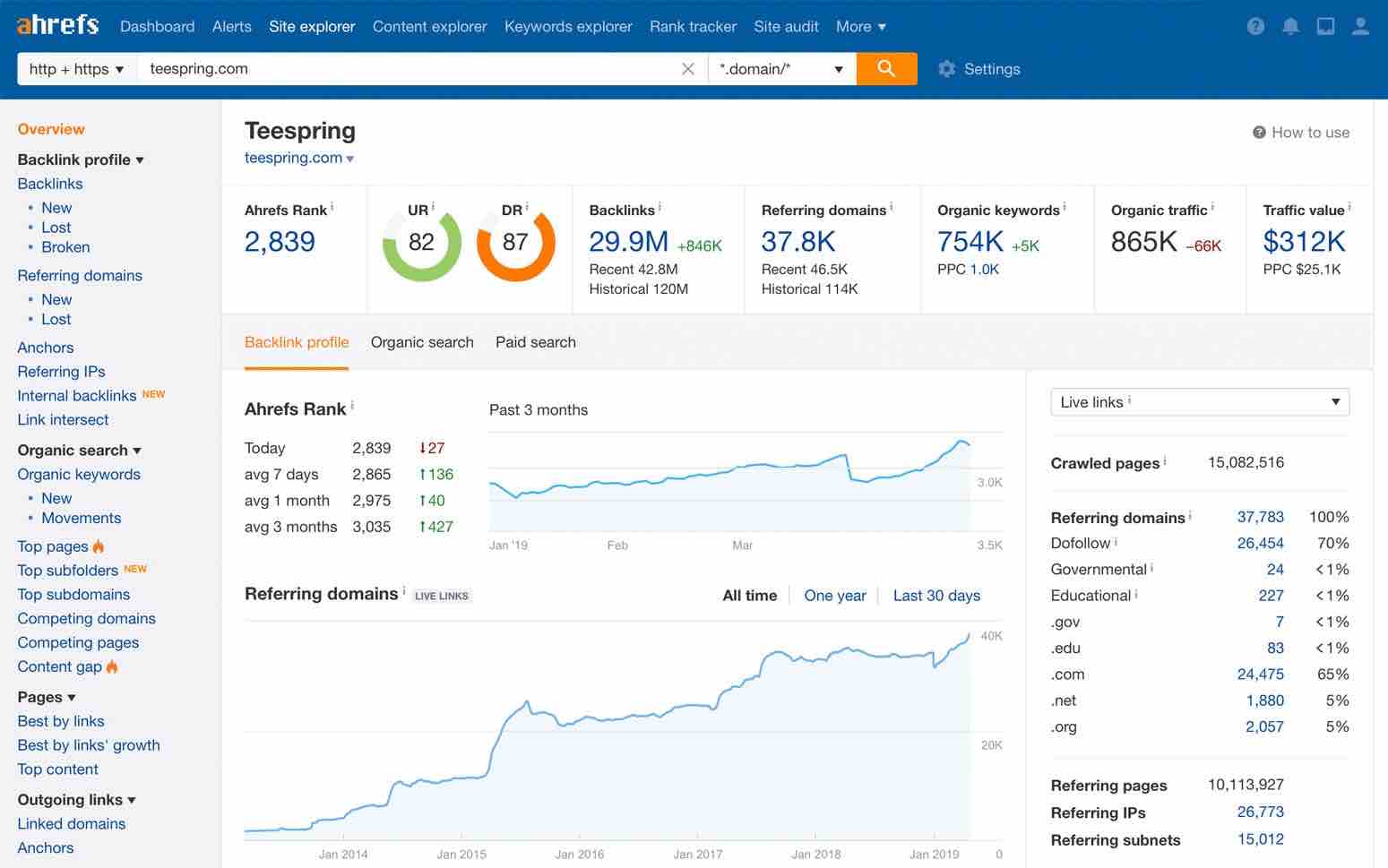
Ahrefs does not have a free version. The tool is paid (check out ahrefs pricing here).
Open Site Explorer
The Open Site Explorer is a part of MOZ SEO tool. It is paid, but has a limited free version.It is a very complete tool because it supports other MOZ functionalities. It is widely used to check two very important metrics in SEO: page authority and domain authority.

It also has a focus on social networks, providing numbers such as:
- Facebook: Data related to shares and likes;
- Twitter: Data related to tweets
SEO Chrome extensions
SEO extensions for Chrome can save you a lot of time. Among the existing ones, two stand out: SEOquake and MozBar .
SEQQuake in action :
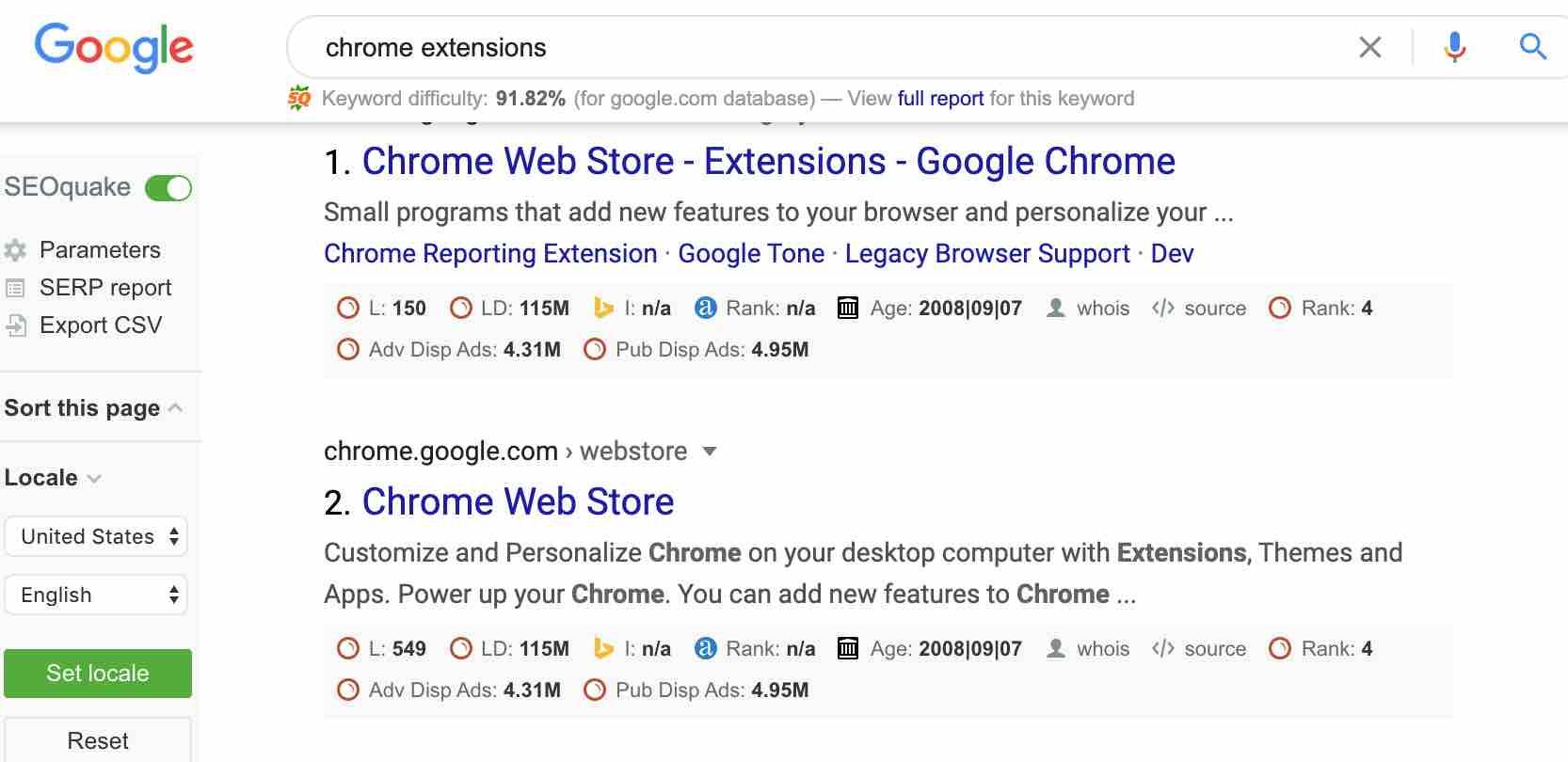
An example of a MozBar extension :
![]()
By grouping the functionality of the two extensions, it is possible to view data almost instantly, such as:
- Page Rank
- Nofollow Links
- Dofollow Links
- Page authority
- Domain authority
- Data referring to social networks (shares, likes…)
- Internal links
- External Links
- URL
- Page Title
- Meta Description
- Heading Tags
- Alt Texts
If you deal with SEO analysis and optimization on a daily basis, these plugins can be extremely useful.
User experience
The user experience, like readability, is a measure of how accessible your content is to the reader. However, it does not refer to the pure text level, but to the whole surrounding, such as design, security and loading time.
In order to provide a good user experience in Google’s eyes, your website should meet the following criteria:
- Security (no spread of malware)
- Protection and respect of the privacy of your users ( SSL certificate , existence of data protection declaration, etc.)
- Optimized for various end devices, resolutions and browsers
- Fast loading time , see below.
- Clear and simple URL structure
- Clear design, simple menu navigation and flat hierarchies
- Font, size and color, as well as line spacing enable the text to be read correctly
- No annoying or aggressive advertising (such as pop-ups that cannot be closed)
Website loading speed
According to Google, website speed is a ranking factor since visitors do not like long loading times and Google wants to show users pages with the fastest possible loading times. Current tests show that website speed is becoming an increasingly important ranking factor.
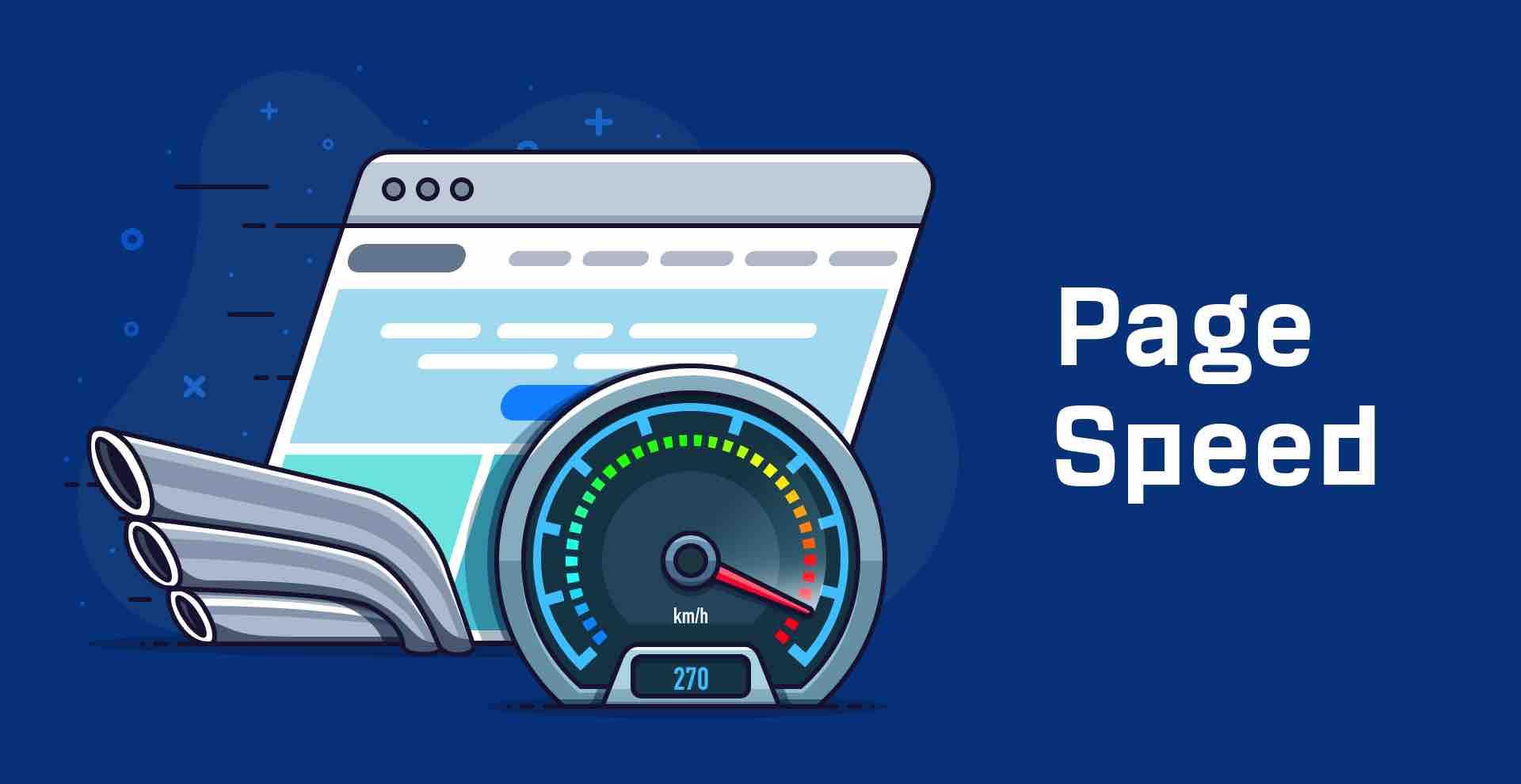
Credits: ahrefs
How important is the loading speed really?
Google has always rewarded websites with clean code and fast website speed. Since Google declared the loading time of a website as a positioning factor in 2010, this has become particularly clear:
“We are introducing a new signal to our search positioning algorithms, namely the loading speed of the website. The loading speed shows how quickly a website responds to requests. Speeding up websites is important not only for the operator of the website, but for all internet users. A faster website means happier users, and our internal studies show that the slower it loads, the less time visitors spend on a website. However, a faster site doesn’t just mean an improved user experience. Recent data shows that improving the loading speed of a website also reduces operating costs. ”
Website speed for SEO ranking varies by country
Note, however, that the positioning bonus is not based on a single general speed rating. A Google patent explains how Google includes several evaluation points in the calculation, which is composed of speed tests from different countries, from different devices and networks.
Let’s say you run a website that loads quickly for visitors in USA, but slower for visitors in the UK, or Asia. When a user searches for their website in the USA, you have a significantly higher position in the search results depending on the loading time than when a user from the UK or Asia searches for the same keyword.
So when redesigning and running, keep in mind that website speed is an important ranking factor in the Google algorithm, both for desktop and mobile websites, and that faster loading times can really improve the ranking of a page. So faster loading times can help get more organic traffic.
Faster website speed = better user experience
Better website speed also improves the experience of website visitors. That shouldn’t really surprise you. How many times have you left a website because the content of the pages was loaded and displayed too slowly? To show you how important website speed is for internet users, here are some interesting statistics:
A case study from Radware shows that 51% of online shoppers in the US don’t make a purchase if the website is too slow.
Radware also found in another study that the demand for fast website speeds has increased over time. For example, a website with a load time of 6 seconds in 2010 had a negative conversion of -40%. In 2014, the same website had a negative conversion of -50%.
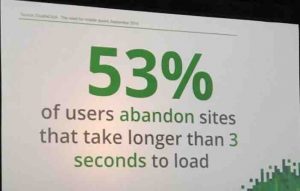
Credits: source
Research shows that 47% of internet users expect a website to load in less than 2 seconds. At peak times, 75% of shoppers would rather switch to a competitive website than stay slow-loading.
Amazon found out a few years ago that 100 milliseconds longer loading time costs a drop in 1 percent of sales .
Aside from making visitors happier, a fast-loading website is also good for business. A study by Strange Loop shows that “a delay of one second can mean a drop in sales of up to 7%.”
Current measurements of the influence of website speed on the ranking show that its importance has increased massively.
In short, companies that want visitors to feel comfortable on their own website and make a purchase must ensure that the pages load in less than 2 seconds. If this does not happen, users do not hesitate to switch to another website.
75% of users leave a website within 4 seconds
Human perception sees everything that is faster than 100 milliseconds as an immediate event. This is a user’s critical rendering path. Because users can easily detect delays of between 100 and 300 milliseconds, they start to leave a website as soon as the website exceeds 1 second of speed. So when you talk about a website speed of 7 seconds on a mobile device, the problem becomes very clear. This explains why 75% of users give up after 4 seconds.
Social media
Increasingly important in the digital market, social media also helps influence SEO.

It is important that your blog uses:
- Sharing box: To increase the number of people who can enjoy your post.
- Like box: It allows more people to like your Fan page and follow your posts.
- Sharing on Twitter: With this button on your blog, more people will be able to tweet your posts. It allows showing how many times the post has been tweeted by users.
Comments
If any visitor left a comment on your post, be it a compliment or a criticism, be sure to reply. This helps your blog to have credibility with the public and allows users to return to it to read your response. In addition, it can also generate interest for them to access other pages or blog posts.
Don’t underestimate mobile
Sounds stupid, but it’s not. The topic and the target group are also important, but in general it can be said that more and more users are visiting your website using their smartphones. If you are not perfectly responsive, offer an app for mobile visitors.

Credits: wpexplorer
Mobile First is an approach that is actually very promising. Optimized not for desktop PCs, but for smartphones and tablets, because more and more people are spending the evening on the couch, accessing specific blogs and websites, reading articles and making purchases. Make sure your website loads faster on mobiles as well. Refer to the section above related to website loading speed.
Strong links or backlinks
What is a backlink ? A backlink is a link that points to your website from another page. Google sees every backlink as a recommendation. The more recommendations you get from other quality websites, the more likely it is in Google’s eyes that you offer high-quality and relevant content on your website.
Backlinks are also very important for success on the web. How to get backlinks to your website ? Try to be mentioned and linked positively on other blogs in your subject area. This is not only advantageous for Google, but usually also brings you many real visitors. Look for blogs that are relevant to the topic and get in touch with their contacts and ask if they could link to you.

Credits: mediashark
On the one hand, it is important for the ranking of a single blog article, i.e. how many backlinks your entire domain has. It is even more important how many backlinks only point to one specific article of your blog. The Domain Authority (DA) and Page Authority (PA) of the analysis tool MOZ are quite good indicators for this, which can be queried directly in Google Chrome using the Open Site Explorer or the MozBar .
Even if you have a blog with a user-friendly design and a fast loading time, and you write articles that are of high quality and are very well keyword-optimized, you might be finding yourself on the third, fourth or fifth page because you have no backlinks .
It is not only the number of backlinks that is decisive, but also and above all their quality. A very good link can be better than 500 weak links. The quality of a link results among other things from the following factors:
- Dofollow or nofollow (dofollow links are always better since they pass link juice)
- Position (in the article is always better than from footer, header, comment area etc.)
- Link text (link text with keywords is in principle better than with URL or brand name, excessive use can lead to a penalty by Google, so be careful!)
- Domain authority of the linking domain (the higher, the better)
- Page Authority of the linking website (the higher the better)
- Formatting the link
- The surrounding content (the more relevant to your keyword, the better)
Such links have always proven to be the most valuable in my years as a blogger. Relevant for topics and from established blogs, that’s where the really good backlinks come from.
Read: Grow Your Website Visitors With Bulk Traffic Ideas
Make yourself a brand
For most, it’s not new, but definitely an important factor is making yourself a brand. Whoever runs a blog is no longer John Doe, but John Doe the super genius, John Doe the dog whisperer, John Doe the marketing specialist. Roger that?
If you want to be successful on the Internet, you always have to present yourself. Readers and customers love being attached to a person, love it when a blog is “personal” and a real person stands behind what is said.
General tips for beginner bloggers
To finish up this article here are some general tips for those who are new to blogging.

Anyone who blogs in a certain industry should stay up to date. That’s why bloggers should read a lot. Above all, of course, other blogs. This also dramatically improves your own writing skills.
Nobody is an island and especially for bloggers, it is very important to make contacts but also to companies in their own industry. After all, at some point you want to receive free test samples, advertising or something similar.
“If you do not know the destination, no way is the right one”. That is a saying and of course that’s also true when blogging. Only if you have one or more goals can you derive the right measures from them. You can only measure success if you have set goals beforehand.
Make plans out of goals. What content do I write? Where do I try to get links? What marketing tools do I use? Which target group do I address? When do I want to achieve what? A good plan also makes everyday work easier.
There are already plenty of blogs. If you want to be successful, you should look for a thematic niche that you can optimally serve. The target group may be smaller at first, but it feels optimally addressed and is more loyal. This is also good for advertisers.
You should never start a blog without at least 5 articles. The first impression counts. You yourself, if you find an empty blog, you will most likely not come back.
Many aspiring bloggers are concerned about whether their articles are good enough. This is completely normal. Get rid of the idea of being perfect. If only perfect blogs were read, the internet world would be very empty.
As mentioned above, content is the most important criterion for the success of a blog. So don’t just chew any news that can be read on hundreds of other blogs. Let your own experiences flow into your articles and write your own opinion. Make your articles unique.
It is very important to blog regularly. Whether that’s every day or once a week is up to you. But if you blog intensively for 2-3 days and then don’t write anything for a month, you will rarely be successful and you won’t find many regular readers.
To keep your readers in mind and stand out from the mass of other blogs , you have to develop your own style, among other things. Your “voice” must have a recognition value. This usually goes through a nice, friendly and communicative style. There are bloggers who get a lot of attention but only for a short time.
Learn from your mistakes
Mistakes are important. And despite all the what you have learned so far, you will also make mistakes . But that’s a good thing, when you learn your lessons. Only those who always learn will be successful in the long term.
As mentioned previously in the article, every comment and every email is worth its weight in gold. Answer questions in comments and respond to criticism. Those who get in touch with their readers create a personal level that turns repeat visitors into regular readers. You will also learn a lot about the wishes of the target group.
The competition can be very helpful. Learn from the competition and implement what you have learned on your own blog. You don’t have to have the best of all blogs. It is enough if it is better than your competitors’ blogs.
Earning money blogging is a nice thing. But if you only blog about money, you will lose interest at some point. Money should never be the number 1 motivation when blogging. Otherwise there is a very good chance that your blog will not be around for long.
Forget all the “get rich overnight” gurus. Building a blog is hard work and most of them don’t get rich. But if you have the necessary patience and motivation, you can make a living from blogging at some point.
The look is important. It’s like real life. If your posts are perfect and your blog looks bad and difficult to use, you won’t find many readers. The best thing to do is to choose a suitable free theme (for example for WordPress ) and gradually adapt it to your ideas.
Conclusion
If you follow these rules for success, you are on the right track with your blog. Of course, you can interpret these requirements a little differently than we did, but the essence of the matter remains and should above all be adhered to.
Especially nowadays it is really difficult to offer something new with a blog, to add value, to attract real visitors who become regular readers. By the way, you shouldn’t think about making money, because that will come later ( via blogging guest post for instance ). Focus rather on quality and what your visitors are looking for. Keep adding content and never give up if you still do not see visitors. Be patient. You will reap the fruits in a few years and not in a few months.
No blog can be created overnight – not even in the fast-paced world of the Internet. How to make a blog successful? With good content, you build up your digital reputation in the long term. Don’t hope for quick successes and maximize profits, but build up good topics and get involved in the community.
Feature image credit: diggitymarketing.com
If you like the content, we would appreciate your support by buying us a coffee. Thank you so much for your visit and support.

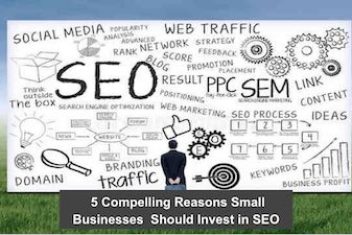


Greate post. Keep posting such kind of info on your blog.
Im really impressed by your blog.
Hey there, You have performed a fantastic job. I will certainly digg it and for my part recommend
to my friends. I am confident they will be benefited from this website.
Thank you for your visit. Will keep working for you guys.